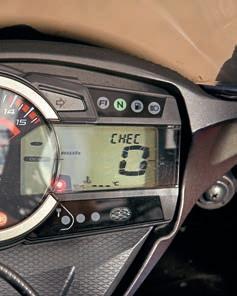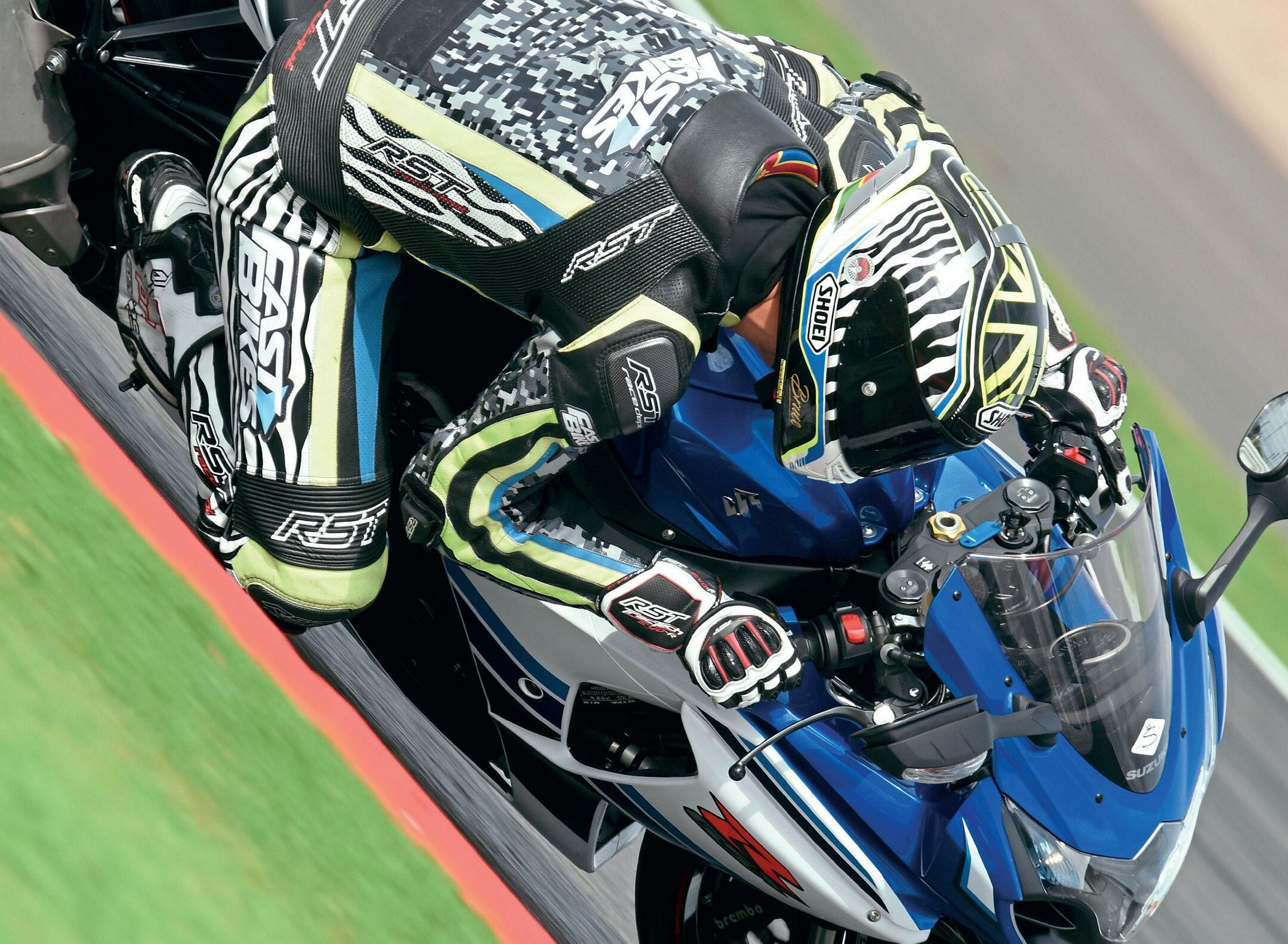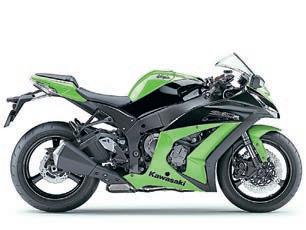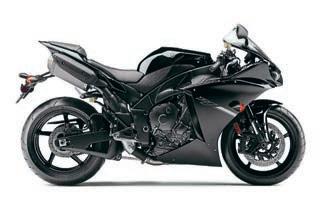
10 minute read
Used Bike Guide
Use dUse d BikeBike GuideGuide
KEEPING IT ANALOGUE
Is the last non-digital GSX-R1000 the best of the bunch?
2012-2016 SUZUKI GSX-R1000

The last of the analogue GSX-R1000 models is a bit of an odd machine as it arrived almost as an apology from Suzuki just at the point when most rivals were already experimenting with advanced rider aids such as traction control and sportsbike ABS. This decision to deliberately shun technology, and also the fact it kind-of looked just like every other GSX-R model before it, conspired to make the 2012 GSX-R1000 a bit forgettable. Flying below the radar, it was one of those bikes that failed to set the world on fire and in an age of tech was quickly destined to sit on the sportsbike sideline rather than be a star striker capturing headlines.
Based on the GSX-R1000 before it (which was first released in 2009 and gained the unfortunate K9 designation that some cruelly said was a reflection of its canine abilities...), the 2012 model initially seemed like simply a bit of a hastily arranged refresh.
The motor gained lighter components, new cams and a tweaked top end (with a reduced rev limit), the suspension was lowered slightly to make the bike more front-end biased to improve the handling, Brembo found its way into the stopping department and the look was updated – but that was about the end of it. Suzuki had hardly set the world on fire, had it? Where was the tech?
However, those who took the time to ride the GSX-R rather than dismiss it based on its spec sheet alone soon realised that this was actually a very special bike indeed...
PRICE GUIDE: £6499-£9000
Cheapest private: £6499
24,733 miles, 2013 model in fair condition with MoT
Our choice private: £7000
8105 miles, 2013 bike, just serviced and very clean with a good service history
Cheapest dealer: £7489
13,785 miles, 2012 bike in white/ blue with an aftermarket can
Our choice dealer: £7599
9731 miles, lovely low mileage bike with a long MoT
ENGINE:
Type: 999cc, liquid-cooled, 16v, inline four Bore x stroke: 74.5mm x 57.3mm Compression: 12.9:1 Fuelling: Electronic Fuel Injection Tested Power: 156bhp @ 11,500rpm Tested Torque: 102Nm @ 10,000rpm
CHASSIS
Frame: Aluminium twin spar F Suspension: 43mm Showa BFF forks, fully adjustable R suspension: Monoshock, fully adjustable Front brakes: Four-piston Brembo monobloc calipers, 310mm discs Rear brake: Single-piston caliper, 220mm disc
DIMENSIONS:
Wheelbase: 1405mm Seat Height: 810mm Wet Weight: 203kg Fuel Capacity: 17.5 litres
SPEED: 0-60: 0-100:
n/a n/a
0-150: n/a Stg ¼ mile: n/a Standing mile: n/a Top speed: n/a
PREVIOUS GENERATION
This generation of GSX-R is very closely related to the unfairly criticised K9/L0/L1 model launched in 2009. Although the 2012 bike is better, if your budget is tight the older one is actually a very nice bike to ride that can be made far better through fairly cost-effective updates to its suspension and brakes. Prices start at about £6000.
ACCESSORIES
As so many rival models came with quickshifters as standard, many GSX-R owners fitted aftermarket items to their bikes in efforts to up the spec. Be very wary of any bike with one on it as they are race systems fitted to road bikes and that means they don’t do the gearbox any favours when used at low revs. Quickshifter-related gearbox woes on road bikes are not uncommon, so always avoid to be on the safe side.

It’s a GSX-R and therefore it will almost certainly come with some accessories. Be wary of aftermarket brake levers as there are a lot of cheap Chinese-built items you certainly wouldn’t trust. And even if they appear to be a known brand, knock-offs aren’t unheard of. Double-bubble screens are common and worth fitting, as is crash protection, but be wary of a tail tidy and ensure it is MoT-compliant. Any tank-grippers or a tank pad may be hiding marks (the same is true of frame stickers) and obviously watch out for non-standard paintwork.
EXHAUST
Suzuki actually gave the GSX-R stainless steel headers with a titanium end can as standard, which is a pretty trick set-up. The headers are good, so there is no need to replace them, but junking the cat (you will need a new link pipe), removing the SET and fitting a free-breathing end can will release a bit more top-end power and mid-range. Always get its fuelling set up by a professional to match the mods, and if the bike you are buying has been altered, ask to see proof of any such work being completed.
FINISH
Sadly, the old Suzuki Achilles’ heel raises its ugly head on the GSX-R and owners do complain about the level of finish. It is mainly down to the brittle nature of the plastics, fasteners’ love of corroding, and the susceptibility of the paint on the tank to scratches. When buying used, check for cracked panels and any marks on the tank. The fasteners will be corroded, they all are, so just assume you will be replacing them with quality aftermarket items.
Suzuki’s R&D department probably argued that just because you have access to the latest tech doesn’t necessarily mean you need to use it – a case they more than proved with the GSX-R. If you are after a litre sportsbike that is simply enormous fun to ride and delivers bags of mechanical grip through a subline throttle response and wonderfully gutsy engine, look no further. This is probably one of the ultimate ‘rider’s bikes’ that’s made all the better for lacking fussy electronics detracting from the riding experience.
Hop on the 2012 GSX-R1000 and everything is recognisable. The dash is a typical sportsbike large analogue speedo with an LCD insert displaying gear position and power mode (okay, it has some electronics in the shape of three generally totally redundant power modes), while the roomy riding position and wide tank has GSX-R written all over it. Big, comfortable, and instantly familiar, you know where you stand with the Suzuki, and this feeling extends to when you fire up the engine.
There is a certain rattle and raw nature to every inline four


The biggie service is the 14,500 valve-clearance check, so bear this in mind when buying a used bike as it will set you back roughly £600. The spark plugs require replacing every 7500 miles alongside the SET checking, throttle valves balanced, and fluid inspected. The suspension linkages should also be inspected and greased if required. Older bikes that haven’t covered the mileage may only receive annual oil and filter changes, so see when the last time a proper service was completed as unbalanced bodies and blocked filters can make the bike run rough.
BRAKES
Never a strong point with Suzuki models, the GSX-R’s OE pad compound is pretty weak and lacking in bite, making the new Brembo monobloc brakes feel disappointing in their performance. By now a set of braided lines to replace the standard rubber ones should be at the top of your shopping list, alongside some high-friction pads.
SET VALVE
The SET (exhaust valve) can be a right old pain on the GSX-R and requires setting up at every service. Many owners simply remove it completely and fit a SET eliminator dongle (about £50), which removes the fault code from the dash. Is it worth doing? Opinions are split as to whether the SET is worth keeping or not, however, the hassle of it potentially seizing or requiring setting up makes removing it the preferred option.
Service interval:
Minor: 7500 Major: 14,500 Valve clearances: 14,500

Service costs:
Minor: £240 Major: £600 Valve clearances: £600
Right fairing: £349.25
RH Engine casing: £301.94
Brake lever: £59.99
UPDATED MODEL
The all-new 2017-onwards GSX-R (which comes in two versions – stock and R) was meant to return Suzuki to contention in the litre bike war. A great road bike thanks to its gutsy motor with variable valve timing, the GSX-R’s look is a bit safe and it lacks a few of the headline-catching electronics. Buy the higher-spec model, which will set you back about £10,000, over the stocker.
GSX-R model and the 2012 bike retains this. However, while it sounds a bit gruff and gives the impression it has an element of the hooligan about it, in reality the very opposite is true. This is one big pussy cat of a bike that, despite being eye-wateringly fast thanks to 156bhp on tap, has bags of smooth mid-range torque (102Nm to be precise) and a glorious throttle response that allows you to open the gas, feel for the mechanical grip it creates, and just rocket forward. A truly wonderful engine in just about every way, it is superb on the road and damn fast on the track, just without necessarily shouting about its abilities. And the same sensation is true of the front end.
As with the engine, Suzuki hardly broke any moulds with the 2012 GSX-R1000’s chassis. The frame itself is basically identical to before, the suspension is tweaked and certainly hasn’t got any flashy semi-active function, and the wheels are unchanged – in fact, aside from the new Brembo brakes it’s pretty much a 2009 GSX-R with a fork kit. But it all works and works fantastically together to bring an overriding impression of completeness and


ALSO CONSIDER THESE:
2012 BMW S1000RR
Private: £8800 Dealer: £9200 The second generation of the RR is more refined than the first, and better for it. A truly brilliant road or track bike but it is pricey, especially with a host of optional extras fitted. Engine: 999cc, l/c, 16v, inline four Power: 182bhp @ 13,000rpm Torque: 106Nm @ 10,750rpm

2012 KAWASAKI ZX-10R
Private: £7000 Dealer: £7500 The choice of the track fiend, the Ninja’s motor loves to be revved and the chassis is happiest on a smooth circuit. On a bumpy back road, not so much... Engine: 998cc, l/c, 16v, inline four Power: 175bhp @ 13,000rpm Torque: 102Nm @ 10,500rpm

2012 YAMAHA YZF-R1
Private: £7999 Dealer: £8500 The updated R1 features traction control but no ABS. Although a bit lardy, the crossplane motor is an absolute peach and the chassis is pleasingly stable on the road. Engine: 599cc, l/c, 16v, inline four Tested Power: 161bhp @ 12,500rpm Tested Torque: 104Nm @ 10,250rpm balance. Yes, it lacks cornering ABS (or any ABS for that matter...) but that’s not an issue with this amount of front end feel. Nope, this is a bike that rewards your riding and responds to every input in a very predictable fashion. And if something is that predictable, you don’t need flashy electronics to keep it all under control – which is exactly how Suzuki should have marketed the 2012 GSX-R1000!
In an era when everyone was only just starting to get to grips with electronic assists, the truth of the matter is that some were a bit rough and ready. Despite their clever electronics, the early S1000RRs were still quite a handful and the ZX-10R wasn’t happy unless it was going ballistic on track. Yes, the R1 had TC, but it was a quite basic system and much of its sales were due to the quirky crossplane motor and Mr Rossi’s antics on track while the Fireblade sold on its reputation for reliability, not necessarily fun. No, if you are after a litre sportsbike to ride, enjoy, and really form a bond with, the 2012 GSX-R1000 is the one to buy. What a shame no one realised this at the time...

Verdict: 9/10
As a road sportsbike, this generation of GSX-R is hard to beat. The motor is fabulous, the chassis sporty and yet balanced, and the price not too horrific. Shame about the brakes, though...



















